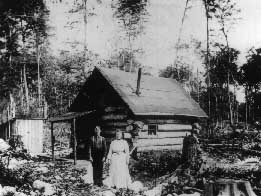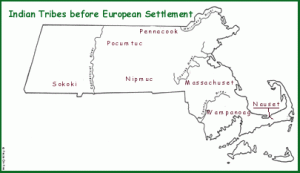Essay: Part I
From Forest To Farm and Back Again
The rich history of Petersham, Massachusetts makes an excellent case study for understanding what happened to the New England forest ecosystem after European colonists arrived. Although

Figure 1: Wilderness Home
Photo courtesy of Lycoming County Historical Society
specific dates for the change from forest to farm and back again may vary from region to region, a similar pattern of clearing forests, farm abandonment, and returning second-growth forests occurred in most regions of the United States.
From Forest ...
The forest ecosystem in central Massachusetts in the 1600s was a subtle patchwork of two types of mature forest communities. In the warmer, lower elevations, the most common trees were oaks and hickories where chipmunks, flying squirrels, turkey, blue jay, and deer grew fat on a diet of acorns, pignuts, walnuts and mocker nuts nosed from under the brittle autumn leaf fall. On the higher, cooler highlands of central Massachusetts, beech, sugar maple, and hemlock made up the hardwood canopy. Red-backed voles, snowshoe hare, red squirrels and porcupine joined the deer gathering seeds under the leathery autumn leaf fall. Ribbons of white pine and chestnut trees flowed through both forest types.
The Native Americans living in the forests were a group of Algonquin-speaking people referred to as the Nipmuc (see below, 'The Nipmuc People'). The Nipmuc cleared small patches of land in the village they called Nichewaug for Indian corn, squash, beans, and tobacco. They also burned the forests regularly to clear large swaths of the forest to improve habitat for game animals. They harvested all the materials to build their homes, transportation, and house wares from the trees in the forests with stone tools and fire. Narrow saplings were used for wigwam and long house poles. Large yellow birch trees were hollowed out to make canoes--the Nipmuc's primary vehicle of transport. Inner bark of white oak was turned into lashing, rope and thread. Hickory bark was used to tan hides. Sugar maple sap was boiled into syrup.

Figure 2: Many Massachusetts place names (including the name of the state) have Algonquin origins. Quon-e-ticut is Algonquin for long, tidal river.
Source: Facts on File 1994
| The Nipmuc People
Originally located in central Massachusetts, northern Rhode Island and northeastern Connecticut, the Nipmuc may have numbered more than 15,000 people before first contact with Europeans. After epidemics due to the diseases brought into their villages by Europeans and casualties and migrations to other tribes due to King Philip's war, this number was reduced by some estimates to perhaps 3,000 people by the late 17th century. About 2,000 Nipmuc were confined to "praying Indian" villages supervised by Puritan missionaries in remote New England locations, and more than 1,000 Nipmuc sought refuge from the ravages of the 17th and 18th centuries wars with New York State and Canadian natives. The Nipmuc are most closely related to the Pequot, Mohegan, Narragansett, Wampanoag and Pennacook tribes in language, custom and tradition. The Nipmuc are currently recognized by the Commonwealth of Massachusetts with about 1,400 members. There are currently 2 reservations - Hassanamisco in Grafton, Massachusetts, and the privately owned Chaubunagungamaug, in Webster, Massachusetts. Source: http://www.newigwam.com/hnipmuc.html (Accessed 2-6-02) |

